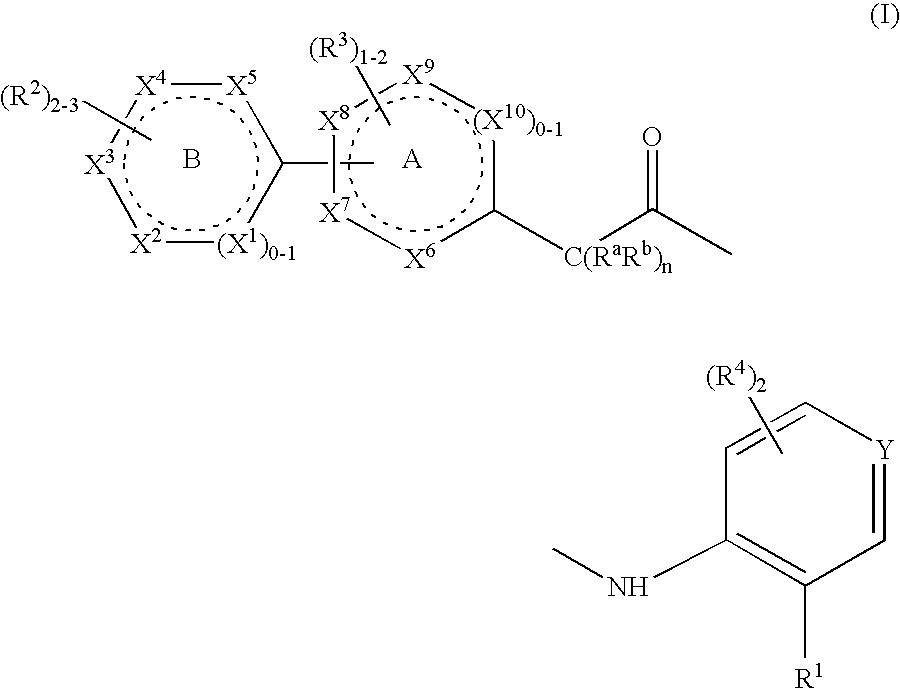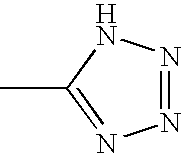Niacin Receptor Agonists, Compositions Containing Such Compounds and Methods of Treatment
a technology of nicotinic acid and receptor agonist, which is applied in the field of biaryl compounds, can solve the problems of limited clinical use of nicotinic acid, increased and greater than normal risk of atherosclerosis and cardiovascular diseas
- Summary
- Abstract
- Description
- Claims
- Application Information
AI Technical Summary
Problems solved by technology
Method used
Image
Examples
example 1
[0222]
[0223] Commercially available 3-(4-iodophenyl)propionic acid (200 mg, 0.72 mmol) was combined with phenyl boronic acid (177 mg, 1.45 mmol), catalytic tetrakis-(triphenylphosphine)palladium (20 mg), and saturated aqueous sodium bicarbonate (1M, 1.45 mL, 1.45 mmol) in (1:1) dioxane-ethanol (5 mL). The reaction mixture was heated at 100° C. overnight, cooled to room temperature, filtered, and concentrated in vacuo. The residue was purified via preparative RPHPLC to give the biaryl propionic acid intermediate. This acid (59 mg, 0.26 mmol) was diluted into toluene (5 mL), treated with thionyl chloride (0.5 mL), and the reaction mixture refluxed overnight. The solvent was evaporated, and the acid chloride product was azeotroped with toluene twice. A third of the remaining yellow oil was diluted into toluene (2 mL), then treated with anthranilic acid (71 mg, 0.52 mmol), and the reaction mixture was heated at reflux for 2 h. The mixture was then cooled to room temperature, concentrate...
example 2
[0224]
[0225] Trimethyl phosphonoacetate (890 mg, 4.88 mmol) was diluted into tetrahydrofuran (10 mL), cooled to 0° C., and deprotonated with n-butyl]ithium (1.6M, 3.7 mL, 5.86 mmol). The reaction mixture was aged 30 min, and then treated with a tetrahydrofuran (5 mL) solution of commercially available 4-iodoacetophenone (1 g, 4.07 mmol). The reaction mixture was then warmed to room temperature, maintained for 1 h, warmed further to 50° C. for 3 h, quenched with water, and partitioned with ethyl acetate. The organic phase was separated, dried over sodium sulfate, and concentrated in vacuo. The product was purified by flash column chromatography (Biotage, SiO2, 5% EtOAc-hexane) to provide the methyl enoate intermediate. This methyl ester (690 mg, 2.28 minol) was saponified with LiOH (1N, 10 mL) in (3:1:1) THF-MeOH—H2O (20 mL) overnight. The reaction mixture was then concentrated in vacuo, diluted with water (20 mL), extracted with chloroform (15 mL), the aqueous phase separated, acidi...
example 3
[0226]
[0227] EXAMPLE 3 can be prepared from its methyl ether derivative EXAMPLE 15 (5 mg, 0.013 mmol), by demethylation with boron tribromide (0.3 mL) in methylene chloride (2 mL). The reaction mixture was aged 2 h, quenched with water, reduced in volume by evaporation in vacuo, and purified directly by preparative RPHPLC to give the desired product: 1H NMR (acetone-d6, 500 MHz) o 11.3 (s, 1H), 8.76 (d, 1H), 8.11 (d, 1H), 7.59 (m, 1H), 7.54 (d, 2H), 7.39 (d, 2H), 7.26 (t, 1H), 7.15 (t, 1H), 7.10 (t, 1H), 6.82 (d, 1H), 3.09 (t, 2H), 2.81 (t, 2H); LCMS m / z 360 (M+−1).
PUM
| Property | Measurement | Unit |
|---|---|---|
| time | aaaaa | aaaaa |
| time | aaaaa | aaaaa |
| temperature | aaaaa | aaaaa |
Abstract
Description
Claims
Application Information
 Login to View More
Login to View More - R&D
- Intellectual Property
- Life Sciences
- Materials
- Tech Scout
- Unparalleled Data Quality
- Higher Quality Content
- 60% Fewer Hallucinations
Browse by: Latest US Patents, China's latest patents, Technical Efficacy Thesaurus, Application Domain, Technology Topic, Popular Technical Reports.
© 2025 PatSnap. All rights reserved.Legal|Privacy policy|Modern Slavery Act Transparency Statement|Sitemap|About US| Contact US: help@patsnap.com



